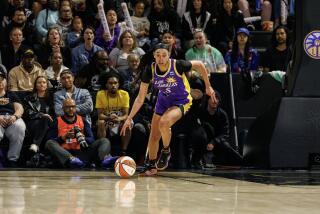Jordanomics Up in Air in Birmingham
- Share via
Fortune magazine, which usually deals with weightier topics, has decided that the “Michael Jordan effect” has had a $10-billion impact on the world’s economy in the 14 years since he joined the NBA.
That figure includes everything from books to videos, from cereal to sunglasses, from sneakers to sweatshirts, from tickets to television revenue, from soft drinks to Sara Lee, from basketballs to batteries to Big Macs.
It includes half of everything Nike, and also half the windfall reaped by David Falk, who represents Jordan, when he sold his agency.
It does not, however, include any revenue earned by the Birmingham Barons, the double-A baseball club for whom Jordan toiled for parts of two seasons.
*
Trivia time: When and where was NASCAR’s first strictly stock car race, and who won?
*
New math: Edwin Pope of the Miami Herald offers:
“Thumbs down to college football’s new playoff system, which might be great yet, if we can find enough PhD’s from MIT to explain it. The only people I’m dead-solid sure can make sense of it are Las Vegas oddsmakers like Roxy Roxborough, who never met a number they didn’t recognize.”
*
Curiosity: Jim Armstrong of the Denver Post wonders, “What is J.D. Drew thinking, now that the player picked ahead of him in last year’s June draft, pitcher Matt Anderson, has been promoted to the Detroit Tigers’ big league roster?”
For one thing, Drew may be considering how to spend his money. He signed a four-year, $7-million contract Friday with the St. Louis Cardinals, who gave him a $3-million signing bonus.
Inflation? Sal Durante, a 19-year-old truck driver from Coney Island, caught Roger Maris’ 61st home run ball and sold it for $5,000 in 1961.
What would the price be for the ball on Mark McGwire’s 62nd homer?
*
Down-scaled: Bob Ryan, defender of all things Boston as a columnist with the Globe, can deal with Red Sox shortstop Nomar Garciaparra’s omission from the American League all-star team, calling it, “About a 7. You want a 10, I’ll give you a 10. Try these All-Star break numbers.
“HRs, 25; RBIs, 100; Runs, 68; Hits, 101.
“That was Detroit’s Hank Greenberg in 1935. He did not make the All-Star team.”
*
Trivia answer: It was June 19, 1949, at Charlotte, N.C., and a Kansan, Jim Roper, won in a ’49 Lincoln after Glen Dunnaway took the checkered flag, was disqualified for a scoring error and failed in a courtroom challenge to the decision.
*
And finally: Bob Smizik offers in the Pittsburgh Post-Gazette:
“In case you missed it, the top ticket price for the New York Knicks went up 8%, from $1,250 to $1,350. . . . The $200 seats were increased to $220.”
Definitely the way to win the hearts and minds of the fan during a lockout.
More to Read
Go beyond the scoreboard
Get the latest on L.A.'s teams in the daily Sports Report newsletter.
You may occasionally receive promotional content from the Los Angeles Times.










